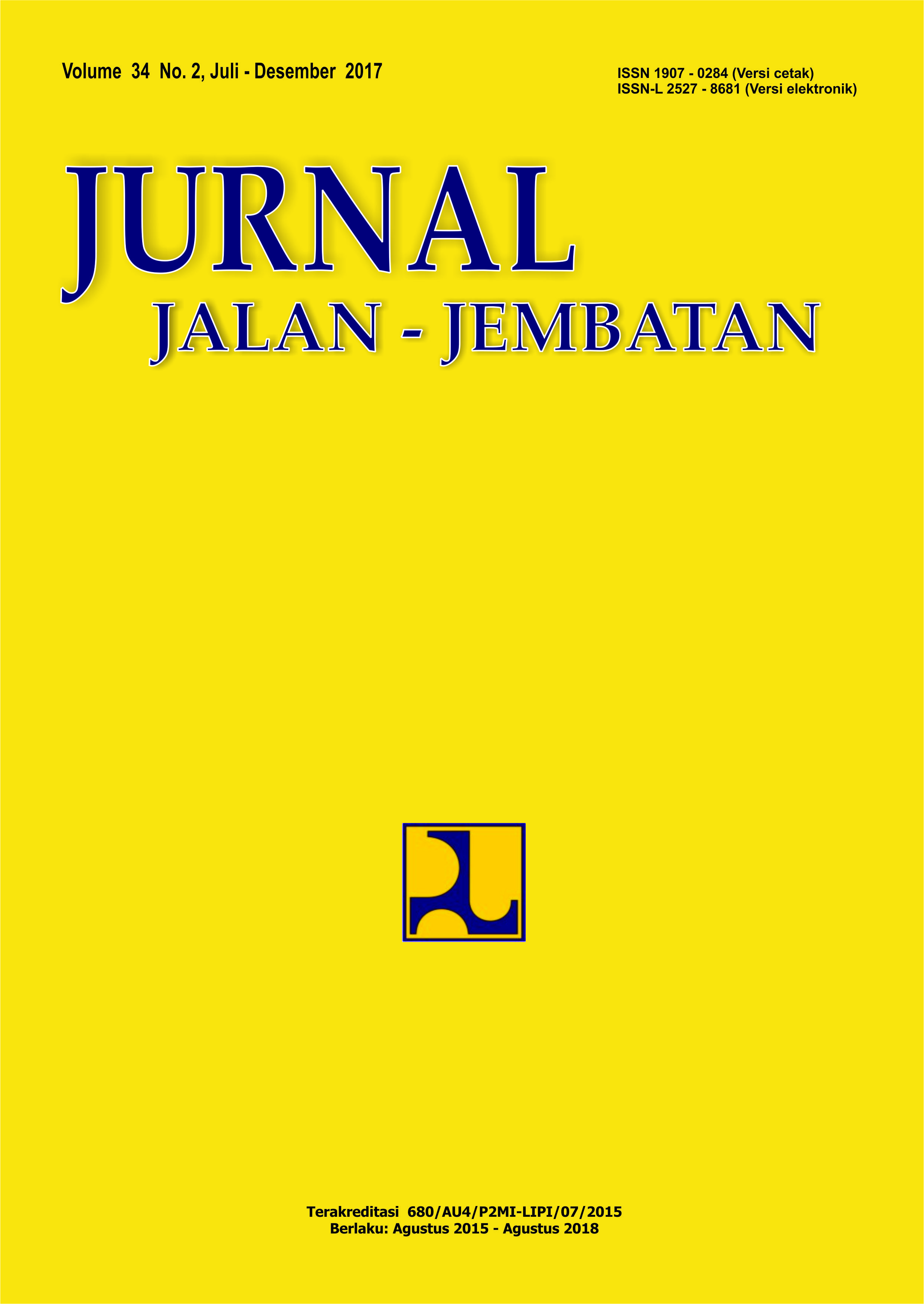PENGARUH BAHAN PEREMAJA TERHADAP KINERJA CAMPURAN BERASPAL PANAS BERGRADASI MENERUS MENGGUNAKAN DAUR ULANG PERKERASAN BERASPAL (THE INFLUENCE OF REJUVENATOR ON CONTINUOUS GRADED HOT MIXED ASPHALT PERFORMANCE USING RECLAIMED ASPHALT PAVEMENT)
Main Article Content
Abstract
ABSTRAK
Â
Dari tahun ke tahun pada pembangunan dan pemeliharaan jalan, khususnya untuk perkerasan beraspal, kebutuhan aspal dan agregat selalu meningkat, padahal aspal selalu mengimpor dan ketersedian agregat pun semakin berkurang. Untuk mengatasi permasalahan tersebut, maka salah satu upaya untuk mengatasinyaadalah dengan memanfaatkan produk limbah yang diperoleh dari aktivitas pemeliharaan perkerasan lentur, yaitu material daur ulang perkerasan beraspal (RAP).Tujuan darimakalah ini adalah untuk mengevaluasi pengaruh tiga bahan peremaja terhadap kinerja campuran beraspal panas yang menggunakan bahan daur ulang perkerasan beraspal (RAP). Metodologi yang digunakan dalam kegiatan ini adalah pengujian dalam skalalaboratorium, yaitu dengan membandingkan antara kinerja campuran beraspal yang menggunakan RAP dan peremaja dengan yang tidak menggunakan peremaja, serta membandingkan juga terhadap ketiga  kinerja campuran beraspal panas yang menggunakan peremaja. Hasil studi ini menunjukan bahwa penggunaan RAP dalam campuran beraspal panas yang tanpa peremaja adalah maksimum 10%.Sesuai hasil pengujian terhadap ketahanan deformasi dan fatik, maka diperoleh bahwa campuran beraspal panas dengan RAP sampai dengan 30% dan menggunakan peremaja RejIRE adalah yang memiliki kinerja yang terbaik.Berdasarkan data tersebut, penggunaan bahan peremaja RejIRE dalam campuran beraspal panas yang menggunakan RAP tidak rentan terhadap terjadinya deformasi dan fatik sehingga dapat menjadi salah satu alternatif untuk digunakan.
Â
Kata kunci: Bahan peremajaRejIRE,kinerja, campuran beraspal panas, gradasi menerus, RAP.
Â
Â
ABSTRACT
Â
From year to year on the construction and maintenance of roads, particularly for asphalt pavement, asphalt and aggregates always increases, when the asphalt always import and aggregate availability also decreases. To overcome these problems, one of the efforts to resolve it is to utilize waste products derived from flexible pavement maintenance activities, ie material recycling of asphalt pavement (RAP). The purpose of this paper is to evaluate the effect of three rejuvenators on the performance of hot mix asphalt which uses reclaimed asphalt pavement.Methodology used in this activity is testing in a laboratory scale, by comparing the performance of hot mix asphalt that uses RAP and rejuvenator with those not using rejuvenator, and compares well against the three performances of hot mix asphalt using a rejuvenator.The results of this study show that the use of RAP in hot mix asphalt that does not use rejuvenator of maximum 10%.According to the results of testing against deformation and fatigue resistance, it is obtained that the hot mix asphalt with RAP up to 30% and RejIRErejuvenator use are performing the best.Based on these data, the use of RejIRE rejuvenator in hot asphalt mixture that use RAP is not susceptible to deformation and fatigue to become an alternative use.                                                            Â
Â
Keywords: Rejuvenator, RejIRE, performance, hot mix asphalt, dense graded, RAP.
Â
Article Details
Authors who publish in this journal agree to the following terms:
-
Authors retain copyright and grant the journal the right of first publication with the work simultaneously licensed under a Creative Commons Attribution License, which allows others to share the work with acknowledgment of the work's authorship and initial publication in this journal.
-
Authors may enter into additional contractual arrangements for the non-exclusive distribution of the journal's published version of the work (e.g., post it to an institutional repository or publish it in a book), with acknowledgment of its initial publication in this journal.
-
Authors are permitted and encouraged to post their work online (e.g., in institutional repositories or on their website) as it can lead to productive exchanges, as well as earlier and greater citation of the published work.
Each submitted manuscript must be accompanied by a "Manuscript Originality Statement" and a "Copyright Transfer Statement".

